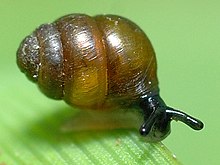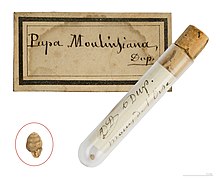Desmoulin's whorl snail
| Desmoulin's whorl snail | |
|---|---|

| |

| |
| Vertigo moulinsiana Holotype MHNT | |
| Scientific classification | |
| Domain: | Eukaryota |
| Kingdom: | Animalia |
| Phylum: | Mollusca |
| Class: | Gastropoda |
| Order: | Stylommatophora |
| Family: | Vertiginidae |
| Genus: | Vertigo |
| Species: | V. moulinsiana
|
| Binomial name | |
| Vertigo moulinsiana | |
| Synonyms | |
| |
Desmoulin's whorl snail (Vertigo moulinsiana) is a species of small air-breathing land snail, a terrestrial pulmonate gastropod mollusc or micromollusc in the family Vertiginidae, the whorl snails.[3]
This species was named in honor of the early-19th-century French naturalist Charles des Moulins.
Habitat
[edit]Desmoulin's whorl snail inhabits calcareous wetlands, where there are tall sedges, saw-sedge (Cladium mariscus), reed-grass (Glyceria maxima) or the reed Phragmites australis.[4]

Distribution
[edit]The distribution of this species is Atlantic (the part of the Palearctic area which is under the direct climatic influence of the Atlantic Ocean), and southern-European.[5]
This small snail occurs across Europe as far north as southern Sweden.[6]
Within Western Europe, only the populations in England (Great Britain) and Ireland are considered to be viable,[6] although further populations exist in the Czech Republic (critically endangered, occupying the White Carpathians Biosphere Reserve, Kokořínsko Landscape Protected Area and Southern Moravia),[7][8][9] in Poland (critically endangered)[10] and elsewhere in Europe (for example: Netherlands,[11] France).[12] Its conservation status in the Czech Republic in 2004–2006 was described as favourable (FV) in the report for the European Commission in accordance with the Habitats Directive.[13] Its conservation status in Spain is endangered and it occurs in two localities only: near Estañá lake and near Lake of Banyoles.[14]
It is also found in Belgium, Switzerland, Italy, Germany, Austria, Slovakia, Hungary, Romania, Denmark, Norway, Finland, Latvia, Lithuania, Estonia, Belarus, Ukraine (Volhynia, critically endangered; around 2014 extinct in Crimea),[15][16] Russia, Georgia and Azerbaijan.[17] Its distribution also include Algeria and Morocco,[17] but it is possibly extinct in Algeria.[1]
This species is mentioned in Annex II of the European Union's Habitats Directive.[18]
Status in the United Kingdom
[edit]In the United Kingdom, Desmoulin's whorl snail is listed as endangered, although it occurs in a number of areas in a band from Norfolk to Dorset, with outlying populations in Kent and the Llŷn Peninsula in North Wales[6] and has probably been under-reported in the past because of its minute size. Its presence on the site of the planned Newbury bypass caused the building of that road to be postponed; the building works were able to go ahead once the snails had been moved to a new habitat nearby. It is reported to have since died out at the new site,[19][20] but the same report states "Desmoulin's whorl snail is now considered less scarce than it was 10 years ago".
Shell description
[edit]The shell is dextral, minute, ovate, ventricose, obtuse at the apex, smoothish, subperforate. The aperture is semiovate, four-toothed, with one tooth on the parietal wall, another on the columella, and two palatals, the lower one longer. The shell has four whorls, parted by a distinct suture, the last doubly larger than all the others together. It is rather solid, glossy, subpellucid and of a uniform fulvous color.[21]
The shell of this species reaches about 3 mm in length. The shell is yellowish or brownish and translucent.[22]
 |
 |
On a stamp
[edit]Deutsche Post featured V. moulinsiana on a 2002 German €0.51 postage stamp as part of a series on endangered species of animals.[23]
References
[edit]This article incorporates public domain text from reference.[21]
- ^ a b Killeen I., Moorkens E. & Seddon M. (2012). "Vertigo moulinsiana". In: IUCN 2012. IUCN Red List of Threatened Species. Version 2012.2. <www.iucnredlist.org>. Downloaded on 1 November 2012.
- ^ Dupuy D. (1849). Catalogus extramarinorum Galliae testaceorum brevioribus specierum nondum descriptorum diagnosibus. pp. 1–4, p. 4, No. 248, Paris.
- ^ MolluscaBase eds. (2023). MolluscaBase. Vertigo moulinsiana (Dupuy, 1849). Accessed through: World Register of Marine Species at: https://www.marinespecies.org/aphia.php?p=taxdetails&id=1050670 on 2023-02-10
- ^ "Action plan for Vertigo moulinsiana". Joint Nature Conservation Committee. 2001–2007. Archived from the original on 27 September 2007. Retrieved 19 June 2007.
- ^ (in Slovak) Lisický M. J. (1991). Mollusca Slovenska [The Slovak molluscs]. VEDA vydavateľstvo Slovenskej akadémie vied, Bratislava, 344 pp.
- ^ a b c "SAC selection species account: Desmoulin's whorl snail".
- ^ "Evropsky významné lokality v České republice" (in Czech). 2003. Archived from the original on 27 September 2007. Retrieved 28 March 2007.
- ^ "Red List of the molluscs (Mollusca) of the Czech Republic". 14 July 2006.
- ^ Beran L. (2006). "New records of Vertigo moulinsiana (Gastropoda: Vertiginidae) and notes on its distribution and habitats in the Czech Republic" (PDF). Malacologica Bohemoslovaca. 5: 14–17. doi:10.5817/MaB2006-5-14.
- ^ Pokryszko B. M. "Vertigo moulinsiana (Dupuy, 1849)". Instytut Ochrony Przyrody Polskiej Akademii Nauk.
- ^ "Vertigo moulinsiana" (in Dutch). Stichting Anemoon. 2005.
- ^ "Recherche de sites par espèce : Invertébrés : Vertigo moulinsiana (Vertigo moulinsiana)" (in French). Ministère de l’écologie et du développement durable. 2007. Archived from the original on 21 September 2007. Retrieved 14 May 2007.
- ^ (in Czech) Dušek J., Hošek M. & Kolářová J. (2007). "Hodnotící zpráva o stavu z hlediska ochrany evropsky významných druhů a typů přírodních stanovišť v České republice za rok 2004–2006". Ochrana přírody 62(5): appendix 5:I-IV.
- ^ Ramos M. A. (1998). "Implementing the habitats directive for mollusc species in Spain". Journal of Conchology, Molluscan Conservation: A Strategy for the 21st Century, Special Publication 2: 125–132.
- ^ Balashov I. & Gural-Sverlova N. 2012. An annotated checklist of the terrestrial molluscs of Ukraine. Journal of Conchology. 41 (1): 91–109.
- ^ Balashov I., Yarotskaya M., Filatova J., Starichenko I., Kovalov V. 2017. Terrestrial molluscs of the Tsyr-Pripyat area in Volyn (Northern Ukraine): the first findings of the threatened snail Vertigo moulinsiana in mainland Ukraine. Vestnik Zoologii. 51 (3): 251–258.
- ^ a b Steffek J. (1996). "Vertigo moulinsiana". 2006 IUCN Red List of Threatened Species. IUCN. Retrieved 9 April 2007.
- ^ "Council Directive 92/43/EEC of 21 May 1992 on the conservation of natural habitats and of wild fauna and flora". Official Journal of the European Union. L 206. European Union: 0007–0050. 22 July 1992.
- ^ "Concern for Newbury bypass snail". BBC News. 27 July 2006.
- ^ Weaver M. (27 July 2006). "End of the road for protected snail". The Guardian.
- ^ a b Pilsbry H. A. & Cooke C. M. (1918–1920). Manual of Conchology. Second series: Pulmonata. Volume 25. Pupillidae (Gastrocoptinae, Vertigininae). Philadelphia. page 178.
- ^ "Vertigo moulinsiana". ARKive. Archived from the original on 22 June 2006. Retrieved 19 June 2007.
- ^ Bartl A. "Bauchige Windelschnecke" (in German). Archived from the original on 7 September 2012. Retrieved 14 May 2007.
- Dupuy D. (1849). Catalogus extramarinorum Galliae Testaceorum in opere cui titulus Histoire naturelle des Mollusques terrestres et d'eau douce qui vivent en France descriptorum. 4 pp.
- Sysoev, A. V. & Schileyko, A. A. (2009). Land snails and slugs of Russia and adjacent countries. Sofia/Moskva (Pensoft). 312 pp., 142 plates.
External links
[edit]- Vertigo moulinsiana at Encyclopedia of Life
- Vertigo moulinsiana at Animalbase taxonomy,short description, distribution, biology,status (threats), images
- Close-up photo of the shell of Vertigo moulinsiana

